Did you know some plants look like lavender but aren’t? Some of these plants have purple or bluish leaves, and others have purple flowers. These plants, however, grow in specific USDA zones.
Either way, these plants make great indoor accents during the fall and other times of the year. Here are some plants that closely resemble lavender.
But don’t worry; there are many other plants with a similar appearance that can match the aesthetics of lavender.
1. Russian Sage
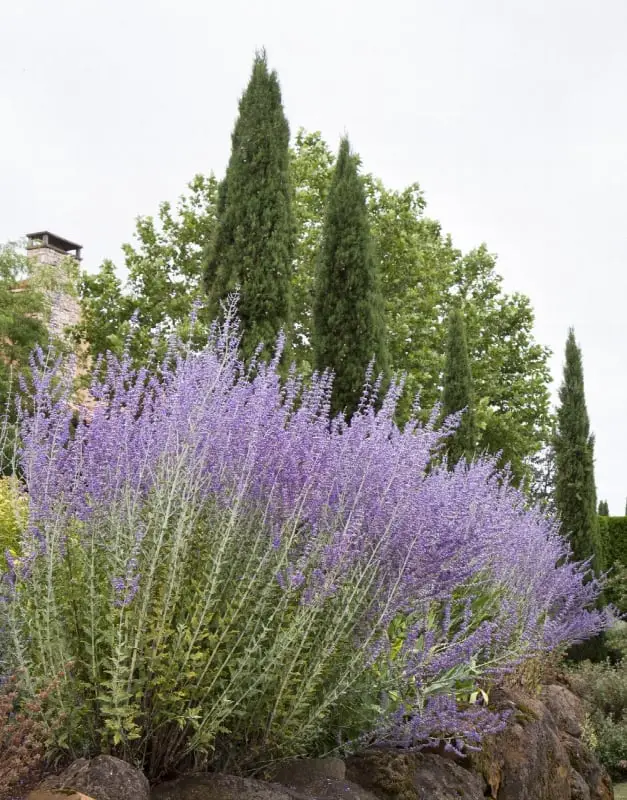
- Origin: Afghanistan
- Size: 3 to 5 Ft.
- Zones: USDA 7-9
- Scientific Name: Perovskia atriplicifolia
The Russian Sage is strikingly similar in appearance to lavender. The herbaceous plant has a shrub-like appearance and grows between three to five feet tall, and they typically grow in cluster-like formations.
These plants have their origins in Afghanistan. They are sufficiently weather resistant and grow almost anywhere.
Their floral tips contain the purple hue that gives these plants their lavender appearance. The plant naturally produces a pleasant aroma.
The smell is useful as it wards off pests and other insects. You can use Russian sage to line your garden and form a protective barrier to shield your other plants.
The plant blooms in sprint time and partially withers in the winter to escape the frost. It is a lovely lavender alternative.
2. Hyssops
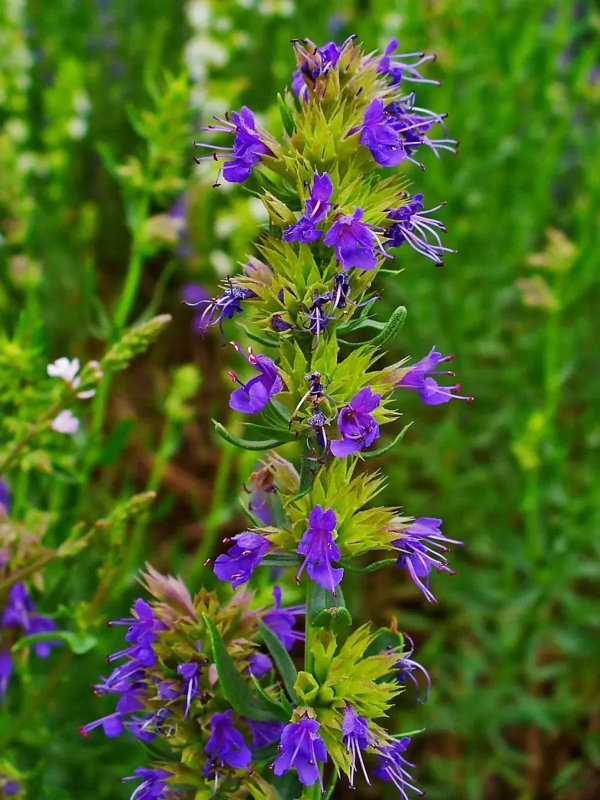
- Origin: Southern Europe and the Middle East
- Size: 1.5 feet high
- Zone: 4 to 8
- Scientific Name: Hyssopus officinalis
Hyssops are plants that are famous for their medicinal properties. The shrub has its origins in Southern Europe and the Middle East.
It is a beautiful perennial bush with purple flowers and green leaves. They are herbaceous plants that grow in clusters, just like the Russian Sage.
The plant usually grows to 8 feet under ideal conditions. They require well-drained soil to thrive. These plants are relatively drought-resistant, and you don’t have to water them constantly—the ideal soil pH conditions range from 6.6 to 8.5.
Hyssops have many medicinal applications. They provide cough relief, antiseptic use, and expectorant applications. It will be best if you prune the hyssops bushes in the spring to regulate their growth.
3. Catmint
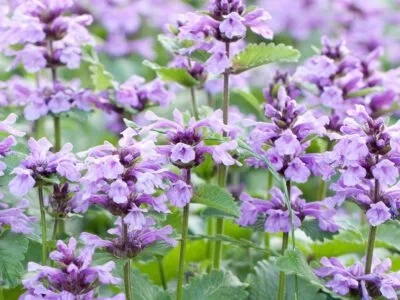
- Origin: Northern Europe, New Zealand, and North America
- Size: 8 to 10 inches tall
- Zone: 3 to 8
- Scientific Name: Nepeta faassenii
Catmint has a similar appearance to some Hyssops species. These are herbaceous plants with green leaves and bright purple floral structures.
They originate from Northern Europe, New Zealand, and North America. Catmint typically grows taller than other plants that look like lavender.
They can reach up to 10 feet under perfect conditions. They grow in dense bushes. Catmint thrives in dry conditions. They have great weather resistance, and you can grow them in USDA 3 to USDA 8 zones.
Catmint has fairly wild growth patterns and requires regular pruning and maintenance. They get used to making soups. Catmint plants have a lovely fragrance that keeps pests and insects at bay.
4. Rosemary
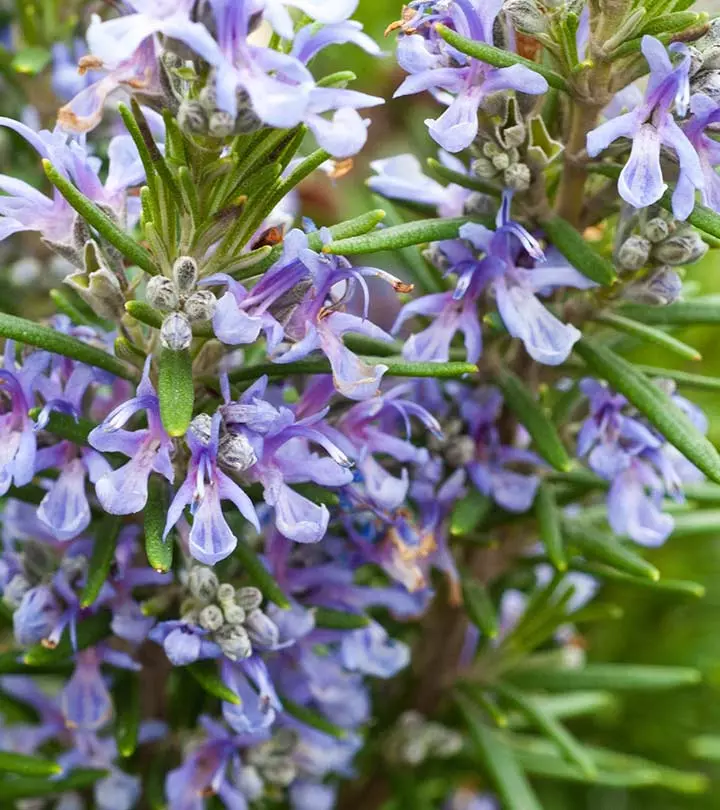
- Origin: South Europe, Asia Minor, and North Africa
- Size: 3.3 to 6.6 feet
- Zone: USDA 7-9
- Scientific Name: Salvia rosmarinus
Rosemary is a shrub that has thin needle-like leaves at its tips. It has a blooming purple flower at its tip.
It is one of the most popular lavender alternatives. The plant is native to southern Europe, Asia Minor, and North Africa.
It is one of the hardiest lavender alternatives. Rosemary thrives in dry conditions. You can grow it in USDA 7, 8, and 9 zones. It offers sufficient weather resistance, particularly in the summer.
The needle-like leaves are a great adaptation as it helps the plant minimize water loss in hot weather. You will need to prune the plant as it can get tall. The plant gets used in the catering industry.
5. Purple Salvias
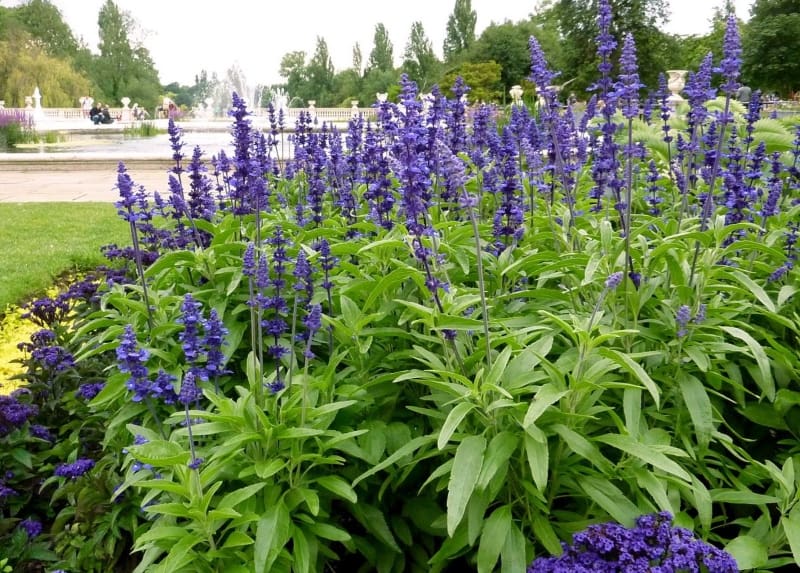
- Origin: Western United States and Utah
- Size: 5 feet
- Zone: USDA 7 to 9
- Scientific Name: Salvias
There are hundreds of species and subspecies of the purple salvias. They are common in the western United States, where they grow natively.
Salvias are characterized by a purple stem and flowers. They are herbaceous plants with low-lying green leaves.
Purple Salvias are sturdy. These plants can withstand harsh hot climates. They typically grow in USDA 9 zones, though some species can grow in zone 11 conditions. These plants require dry soils to thrive.
These plants don’t require active care save for occasional pruning. Be sure to clip any brown stems before springtime.
Purple Salvias are beautiful, especially if you grow them in clusters. Dry heading the plants makes them grow healthy.
6. Basil

- Origin: tropics of Africa, America, and Asia
- Size: 18 to 24 inches
- Zone: USDA 9 to 11
- Scientific Name: Ocimum basilicum
Basil bears the closest resemblance to lavender when compared to all other plants. The basil subspecies in the picture with deep purple leaves originate from Africa and Asia. It gets used as a condiment in the catering industry.
The plant is quite resilient. It thrives in many conditions, and you do not have to take a hands-on approach when cultivating it.
It requires sufficient sunlight to grow and thrive. It does well in conditions above USDA zone 9 and is fairly heat-resistant.
You can prune basil to optimize the growth height. Cutting off the flower heads makes basil grow taller. If you wish to cook with basil, clip the leaves once every six weeks.
7. Mealey Cup Sage
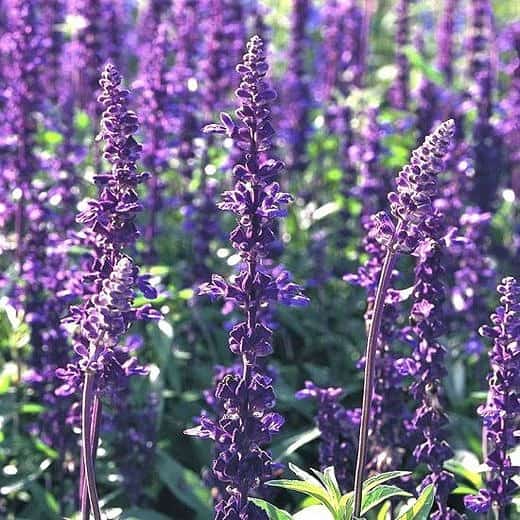
- Origin: Western United States and Utah
- Size: 1 to 3 feet tall.
- Zone: USDA 8 to 10
- Scientific Name: Salvia Farinacea
Mealey Cup Sage is a herbaceous plant that thrives in the western states of the USA. It is a shrub-like plant that typically grows in clusters.
The plant has a thin purple stem with purple flowers. It has green leaves located towards the base of the plant.
Like other sage species, Mealey Cups are conditioned to withstand harsh climates. These plants typically thrive in USDA 10 zones.
They require soils that drain fast, as water-logged soils could bring osmotic disequilibrium. Meally cup sages require lots of sunshine.
The plants have virtually no pests or known diseases. They work well as a perimeter around your garden, offering protection from pests and vermin.
8. Mexican Bush Sage
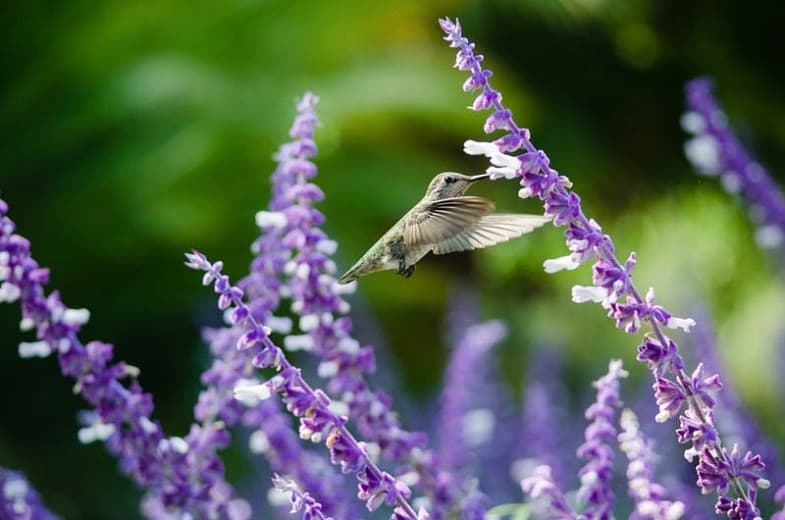
- Origin: Central and Eastern Mexico
- Size: 4 feet tall
- Zone: USDA 8b to 11
- Scientific Name: Salvia Leucantha
Mexican Bush Sage is widespread in Central and Eastern Mexico, where they are native. Salvias get distinguished by their purple stems and flowers. They are herbaceous plants with green leaves that grow low to the ground.
Mexican Bush Sage is a hardy plant. These plants can survive extreme heat. They typically grow in USDA Zones 9 and 10, though some species can thrive in Zone 11. To flourish, these plants need dry soil.
Except for occasional pruning, these plants do not require active care. Before spring, make sure to cut any brown stems.
Purple Salvias are particularly beautiful when grown in clusters. Dry heading the plants promotes healthy growth. The plant attracts bees and hummingbirds, which can help pollinate the plants.
9. Wisteria
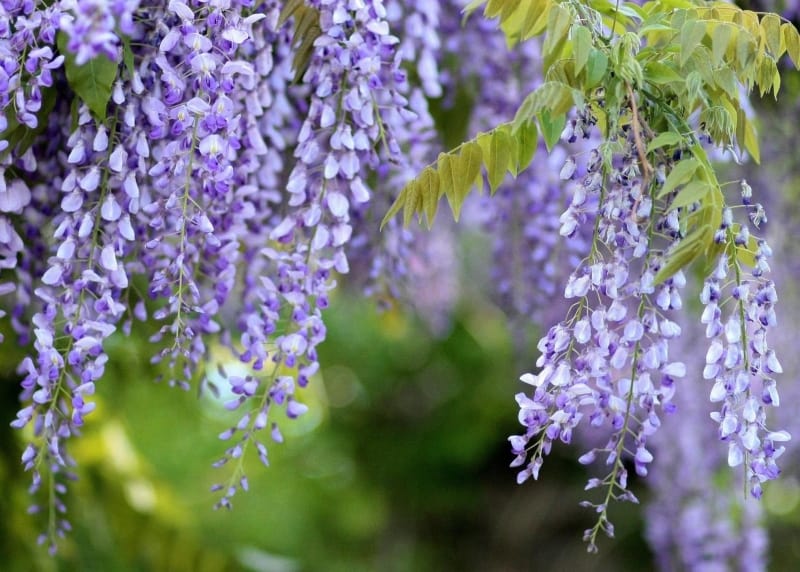
- Origin: Guangxi, Guizhou, Hebei, Henan, Hubei
- Size: 10 to 25 feet
- Zone: USDA 5 to 9
- Scientific Name: Wisteria Sinensis
Wisteria is a beautiful plant that originates from China. It is a climber with green leaves and purple flowers.
The plant typically attaches itself to taller trees and structures and spreads to get as much sunlight as possible.
It has a woody stem which gives it a bit of heat resistance. The tree can thrive in areas between USDA 5 and USDA 9.
These conditions are typically dry. Wisteria has no special soil requirements as it grows in acidic or alkaline soils.
You should know that the plant is toxic to pets and farm animals and should not be ingested. It is relatively resistant to pests and diseases. To optimize the growth height, you should prune it regularly.
10. Catnip
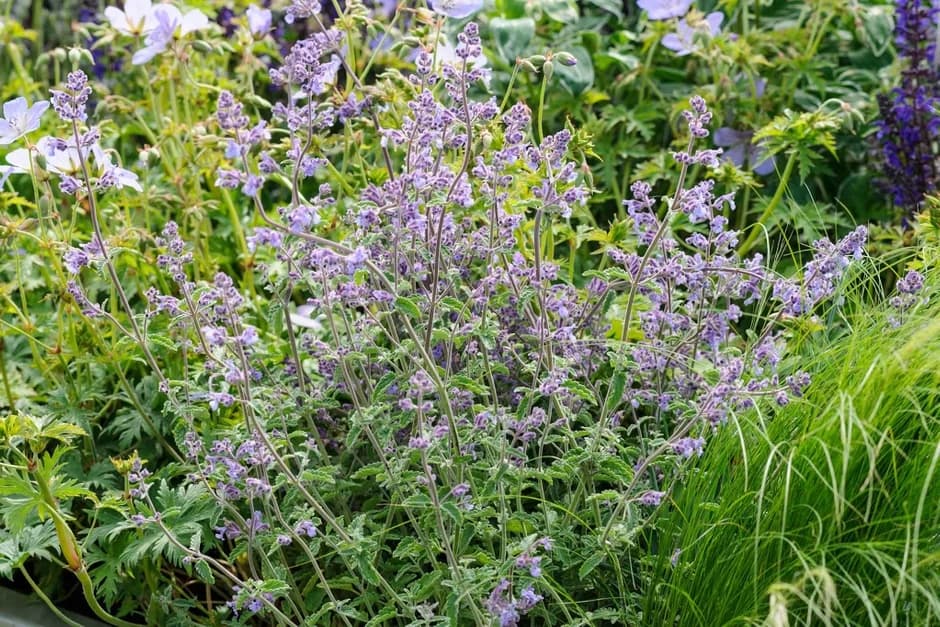
- Origin: southern and eastern Europe, the Middle East, Central Asia,
- Size: 20 to 40 inches
- Zone: USDA 3 to 9
- Scientific Name: Nepeta cataria
These are herbaceous plants with green leaves and bright purple patterns toward the leaf margins. It typically grows in bushes and shrub-like structures.
They originate from southern and eastern Europe, the Middle East, and Central Asia. Catnip is common in the United States and Mexico.
The plant thrives in many different conditions. Some species are quite water-dependent and don’t grow outside USDA 3 conditions. Others evolved to withstand hotter climates and do not require special soil conditions to thrive and grow.
The plants can grow to 40 inches depending on the soil conditions and the subspecies. Catnip is pet-friendly and has a calming effect on cats and other animals.
11. Caradonna Salvia
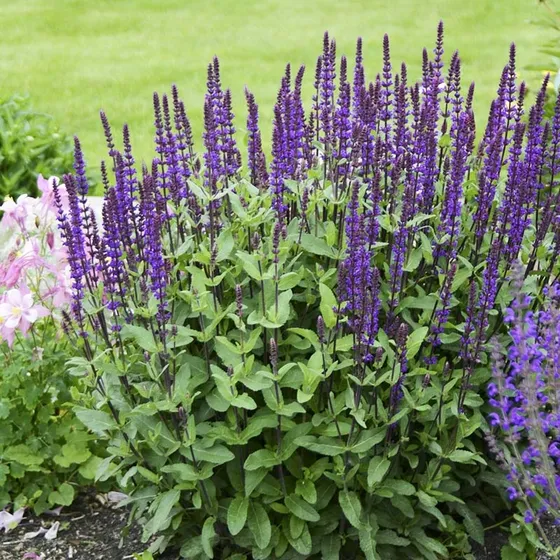
- Origin: Europe and west-central Asia
- Size: 8 to 10 inches
- Zone: USDA zone 4 to 8
- Scientific Name: Salvia nemorosa
Cardona Salvia is a perennial herb native to Europe and west-central Asia. It’s a herbaceous plant that grows in clusters. The plant has purple flowers on a thin purple stem. It has green leaves near the plant’s base.
Like other sage species, Cardona Salvia has evolved to tolerate harsh climates. These plants usually thrive in USDA Zones 10 and 11.
They require fast-draining soils because saturated soils can cause osmotic disequilibrium. Cardona Salvia generally requires a lot of sunlight.
There are no known pests or diseases that affect the plants. They are effective as a rim around your garden because they protect against pests and vermin.
12. Allium ssp
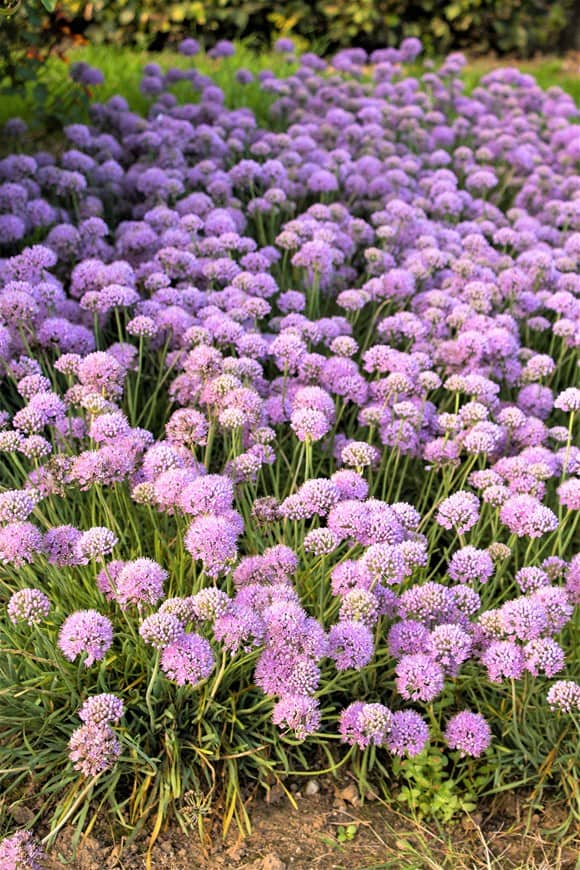
- Origin: France and Italy
- Size: 0.65 feet
- Zone: USDA 4 to 8
- Scientific Name: Allium Vinale ssp
Allium ssp is a herbaceous species that has tall green stems. It has bulb structures that house purple-colored floral bits.
It has other color variations like pink, green and yellow. They grow in clusters. Unlike most plants in this list, they are not shrub-like.
They are weather resistant and can grow just about anywhere. The purple hue in their floral tips gives these plants their lilac appearance. The plant emits a pleasant aroma on its own.
The smell is beneficial because it repels pests and other insects. Allium ssp can line your garden and create a protective barrier for your other plants. The plant blooms quickly and partially withers in the winter to avoid frost damage.
14. Petunia
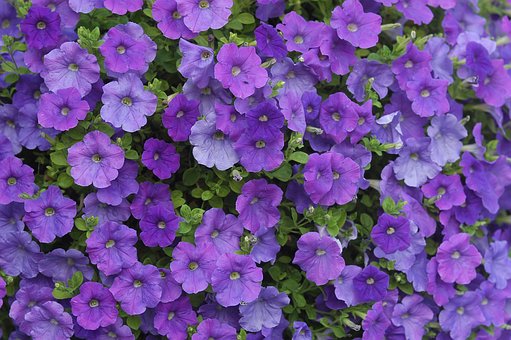
- Origin: South America
- Size: six to eight inches
- Zone: USDA 10 to 11
- Scientific Name: Petunia X Hybrida
Petunia is a sturdy plant that typically grows in South America. It gets characterized by its beautiful flowers that have a trumpet shape. Other flower color variations are yellow, red, white, and orange.
The plants are relatively shorter than other lavender-like species. Under ideal conditions, they can reach a height of 10 feet.
They form dense bushes. Petunia grows well in dry conditions. They have excellent weather resistance and can be grown in USDA zones 10 and 11.
The beautiful flowers typically get used in hanging baskets to enhance their aesthetics. It is suitable for folks who live in areas that don’t experience heavy rainfall. Unfortunately, these plants typically don’t do well outside tropical conditions.
15. Larkspur

- Origin: The Mediterranean
- Size: 3 to 4 feet
- Zone: USDA 2 to 10
- Scientific Name: Consolida ajacis
Larkspur is a beautiful seasonal flower plant. The plant has a thin green stem surrounded by flowers springing in a radial pattern.
You could grow Larkspur in nearly any condition. Its range is amazing, as it can withstand areas that typically experience heavy rains and dryer areas. It has no specific soil requirements, thriving in acidic or alkaline soils.
These plants self-seed, meaning they regrow yearly, so you don’t need to keep planting them. Note that the flowers harm pets and might not suit all homes.
Their toxins keep pests and other vermin away from your house. Larkspur doesn’t require special attention or pruning. It is a self-regenerating plant that does well on its own.
Conclusion
Now you know plants that look like lavender. Lavender is a gorgeous plant. Its deep purple appearance adds to the beauty of any environment or residence. These plants grow only in specific USDA zones.
Not to fret, numerous other plants have a similar appearance or can complement lavender aesthetics. These plants thrive in various climates, and you can find a few suitable for you.
 Being Human
Being Human




